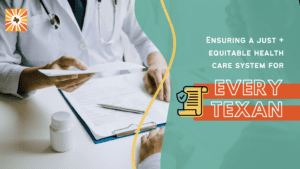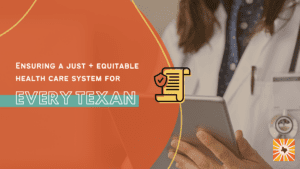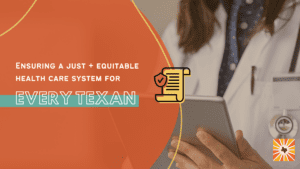
New Federal Updates to Affordable Care Act Marketplace Policy
The Centers for Medicare and Medicaid Services (CMS), the federal agency in charge of regulating most types of health insurance, just released a final rule that makes changes to the ACA
Medical debt is experienced by millions of Texans.
When people become sick or suffer an accident, the cost of their healthcare may end up becoming their greatest burden. Medical debt is debt incurred from medical expenses that patients are unable to pay in full. One in four Texas consumers have medical debt on their credit report.


While medical debt can impact Texans all over the state, it disproportionately affects those in neighborhoods of color: nearly one in three (29 percent) compared to only one in four (23 percent) of Texans in white neighborhoods.
When you face a medical emergency, the last thing you want to think about is how to pay for it. Unfortunately, when people can’t pay their medical bills, costs turn into mounting medical debt that compromises patients’ health and financial security, harms their credit scores, and can even limit a patient’s housing and job opportunities. Medical debt is experienced by millions of Texans, owing on average larger amounts than those in other Southern states, and more than the U.S. average.
Many types of household debt put families in stressful and potentially devastating situations. Debt from sources such as auto and retail loans, payday lending, and education influences people’s decisions to make necessary purchases for themselves and their families, limits people’s saving and investment potential, and spurs financial instability. However, unlike other sources of debt, people often fall into medical debt with total lack of consumer control. Seeking medical care differs from other consumer transactions since patients have little price transparency or provider options when receiving medically necessary services, especially in the case of an emergency.
Although anyone with a large amount of medical expenses may be exposed to harmful medical debt, people without health insurance, those with chronic health conditions, and people earning low incomes are more likely to experience overly burdensome medical debt, and to face negative financial and health consequences as a result.
Increasingly, the national discussion on health care reforms has focused on affordability of comprehensive care, with a goal of eliminating the risk of financial ruin due to health care costs. The Texas Legislature has a number of tools they can employ to reduce medical debt and its unfair toll on people of color.
Read more about Texas’ mountain of medical debt here.

The Centers for Medicare and Medicaid Services (CMS), the federal agency in charge of regulating most types of health insurance, just released a final rule that makes changes to the ACA

As if navigating health coverage options isn’t hard enough for most Texans, a multitude of health plans not required by federal law to comply with the consumer protections in the

Every Texan appreciates the opportunity to provide written recommendations to the Texas Health and Human Services Commission (HHSC) regarding the agency’s development of the Legislative Appropriations Request (LAR) for 2026-2027.

View this testimony as a PDF here. Every Texan (formerly CPPP) appreciates the opportunity to express support for HB 12 by Representative Rose. The Benedictine Sisters of Boerne, Texas, founded